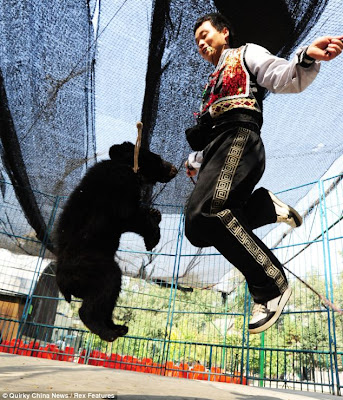By DAVID DERBYSHIRE
I'm the king of the swimmers: Two-year-old Mr Bernie - one of 330 orphaned apes at the Orangutan Care Centre and Quarantine in Borneo - will do just about anything to avoid taking a plunge
As generations of parents will gladly testify, bath time often turns into a battleground when toddlers are involved.
And as these adorable pictures show, it’s not just human babies who get all steamed up when it’s time to take a dip.
Two-year-old Mr Bernie — one of 330 orphaned apes at the Orangutan Care Centre and Quarantine in Borneo — will do just about anything to avoid taking a plunge. With four strong hands able to firmly grasp the sides of the bath, getting him into the warm, soapy water can be a soggy struggle.
Not happy: In the wild, orangutans usually shy away from water, preferring to keep themselves clean through picking out bugs and dirt with their long fingers. But at the orphanage there are no ape mums to help out
In the wild, orangutans usually shy away from water, preferring to keep themselves and their babies clean through picking out bugs and dirt with their long fingers. But at the orphanage there are no ape mums to help out.
Some toddler apes — such as Charlie, pictured here in a green towel — are fans. Mister Bernie, however, is not. He was brought to the orphanage in July 2010.
A spokesman from the centre said: ‘He was a scrawny, scared little thing with hair matted from sticky sap. After a long bath, some motherly attention, and countless bananas, Mr Bernie started thriving in his new home. He is now strong, healthy and handsome.’
Care: The centre was set up in 1998 to help orphaned and rescued orangutans learn the skills they need to live independently in the wild
The centre was set up in 1998 to help orphaned and rescued orangutans learn the skills they need to live independently in the wild.
Located in the village of Pasir Panjang near Tanjung Puting National Park, a team of surrogate human mums live with the youngsters day and night.
Each day, the orphans are taken into the 200 acre forest surrounding the centre where they forage, play and hunt, carefully watched by their carers.
Under wraps: Some toddler apes - such as Charlie, pictured (right) - are fans. Mr Bernie (left), however, is not
source: dailymail
My mom speak english...
-
https://www.facebook.com/teenoikidshop/videos/420355528324348/ My Facebook
My Google+ Contact me
8 years ago



































































